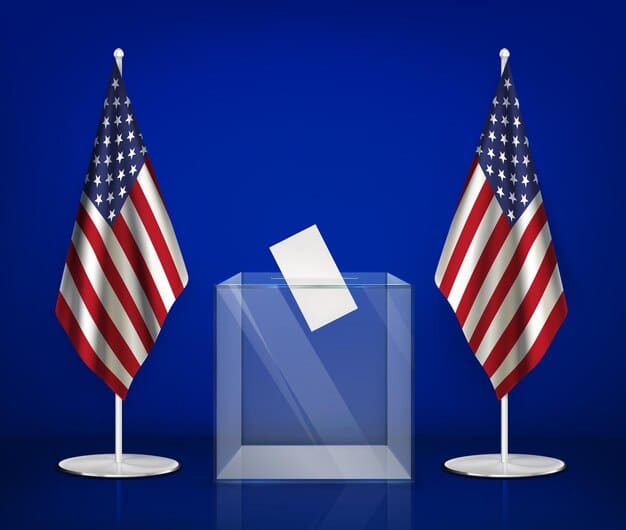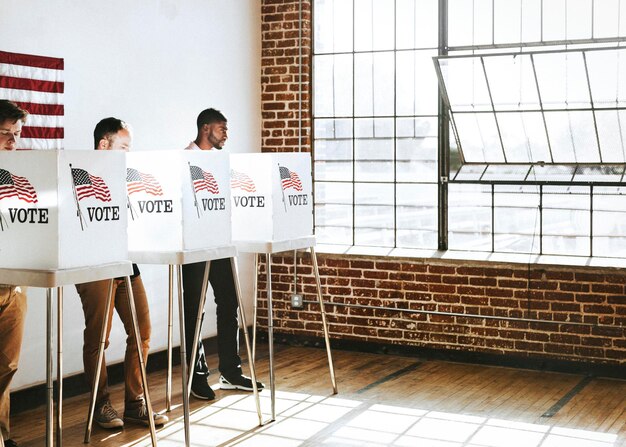US Campaign Finance Policy: New Regulations & Election Impact

US campaign finance policy is a complex and evolving legal framework governing political donations and spending, with recent regulatory shifts profoundly influencing election dynamics, transparency, and the perceived fairness of democratic processes.
Understanding US campaign finance policy: understanding the new regulations and their impact on elections is crucial for any engaged citizen or political observer. This intricate set of rules, constantly reshaped by legislative efforts and judicial rulings, plays a pivotal role in determining who can run for office, how campaigns are funded, and ultimately, the outcomes of elections across the United States.
the evolution of us campaign finance law
The landscape of campaign finance in the United States has been shaped by a series of landmark legislative acts and Supreme Court decisions, each attempting to balance free speech rights with concerns about corruption and undue influence. From early attempts to curb corporate power to modern debates over super PACs, this area of law is a testament to the ongoing tension between public interest and private contributions.
The early 20th century saw the initial federal efforts to regulate campaign finance, primarily focused on preventing corporations and labor unions from making direct contributions to federal campaigns. The Tillman Act of 1907 marked the first federal law prohibiting corporate contributions, a response to widespread concerns about the corrupting influence of big business in politics. This foundational act laid the groundwork for future regulations, setting a precedent that direct corporate and union money should be kept separate from candidate campaigns.
key legislative milestones
Subsequent decades brought further refinements and expansions to campaign finance regulations. The Federal Election Campaign Act (FECA) of 1971, and its significant amendments in 1974, represented a comprehensive overhaul, establishing contribution limits, disclosure requirements, and creating the Federal Election Commission (FEC) to enforce these laws. FECA’s original intent was to inject transparency and fairness into campaign funding, aiming to reduce the appearance and reality of corruption by mandating that donors and recipients of significant contributions be publicly identified.
- FECA (1971/1974): Established federal matching funds for presidential primary elections, capped individual and PAC contributions, and mandated extensive financial transparency for campaigns.
- Bipartisan Campaign Reform Act (BCRA) of 2002 (McCain-Feingold): Sought to eliminate “soft money” (unregulated donations to political parties) and restrict issue ads close to elections that were essentially thinly veiled campaign ads.
- Citizens United v. FEC (2010): A pivotal Supreme Court decision that held that corporations and unions have the same First Amendment free speech rights as individuals, allowing them to spend unlimited amounts of money on independent political expenditures.
judicial interpretations and their impact
The Supreme Court has played an outsized role in defining the boundaries of campaign finance law. Buckley v. Valeo (1976), for instance, upheld contribution limits as a means to prevent corruption but struck down spending limits as infringements on free speech. This decision introduced the distinction between contributions (which can be limited) and independent expenditures (which generally cannot be limited), a dichotomy that continues to shape the legal framework.
The landmark Citizens United v. Federal Election Commission (2010) decision fundamentally reshaped the landscape. By ruling that corporations and unions have the same free speech rights as individuals, the Court allowed them to spend unlimited amounts of money on independent political expenditures, paving the way for the rise of Super PACs and other independent expenditure groups. This ruling dramatically increased the role of dark money and largely deregulated independent spending, sparking a new era of campaign finance. Subsequent cases like McCutcheon v. FEC (2014) further chipped away at donation limits, invalidating aggregate limits on individual contributions. These judicial interventions underscore the dynamic nature of campaign finance, constantly balancing constitutional rights with regulatory objectives.
The continuous legal challenges and interpretations highlight the inherent difficulty in regulating political speech while upholding democratic principles. Each ruling sparks new debates and often leads to innovative ways for money to flow into politial campaigns, creating a perpetual cycle of regulation and adaptation. Understanding this historical progression is essential to grasp the complexities of current campaign finance policy and its profound implications for democratic processes.
new regulations in focus: recent policy shifts
The dynamic nature of US campaign finance policy means that new regulations, often born from legislative efforts or court interpretations, continually emerge, creating a shifting legal landscape that significantly impacts elections. These shifts aim to address perceived loopholes, enhance transparency, or respond to judicial mandates, but their effects are often complex and far-reaching. The regulatory environment is a constant negotiation, with consequences that ripple through every aspect of political campaigning.
While comprehensive, sweeping reforms are often difficult to pass through Congress, incremental changes and targeted regulatory actions by bodies like the Federal Election Commission (FEC) or the Internal Revenue Service (IRS) can still have a tangible impact. Furthermore, state-level regulations often serve as innovative laboratories for new approaches, some of which may eventually influence federal policy.
key regulatory changes and their mechanisms
Recent developments often focus on areas such as disclosure, coordination, and the definition of what constitutes a political expenditure. For instance, debates continue on how to broaden disclosure requirements for “dark money” groups that spend heavily in elections without revealing their donors. While legislative attempts to mandate more transparency have largely failed at the federal level, advocacy groups and some states continue to push for greater clarity in political spending. The difficulty in passing broad reform at the federal level often forces focus on smaller, targeted changes or state-level initiatives.
- Enhanced Disclosure Rules (limited): Some states and localities have implemented stricter disclosure requirements for politically active non-profit organizations, pushing for more transparency beyond federal mandates.
- Digital Ad Regulations: Growing concerns over foreign interference and opaque digital advertising have led to calls for regulations similar to those for traditional media, pushing for disclosure of who pays for online political ads.
- FEC Enforcement Shifts: While often hamstrung by partisan deadlock, shifts in FEC commissioner appointments can subtly alter enforcement priorities, influencing how existing regulations are applied and interpreted.
the influence of technology on regulation
The rapid evolution of technology, particularly in digital advertising and online fundraising, presents new challenges for campaign finance regulation. Existing laws, largely designed for an era of television and print media, struggle to keep pace with micro-targeting, programmatic advertising, and the speed at which information (and misinformation) can spread online. This technological gap requires a constant re-evaluation of how regulations apply to the digital sphere. The rise of new platforms and communication methods means regulators are always playing catch-up, leading to a complex and often ambiguous regulatory environment.
For instance, the debate over regulating political ads on social media platforms highlights the difficulty in applying traditional campaign finance rules to new forms of political communication. Should a viral meme be considered an “independent expenditure”? How should platforms police content funded by unknown sources? These questions underscore the need for innovative regulatory approaches that can adapt to changing technological landscapes without stifling free speech or innovation. The failure to adequately address these questions has led to significant concerns about foreign interference and domestic disinformation campaigns, further complicating the regulatory efforts.
The implementation and enforcement of these new regulations are often met with legal challenges, reflecting the ongoing tension between constitutional rights and the public interest in transparent and fair elections. The outcome of these challenges often further refines how campaign finance policy is understood and applied, creating a system in constant flux. The journey of these regulations from proposal to enforcement is a long one, marked by legal battles and political maneuvering, ultimately shaping the framework for future elections.
impact on elections: how money shapes campaigns
The influence of campaign finance on US elections is undeniable, moving beyond mere anecdotes to systemic effects that shape candidate viability, campaign strategies, and ultimately, election outcomes. Money in politics isn’t just about who wins; it’s about who can compete, what issues get prioritized, and the very perception of democratic fairness. The current regulatory environment, especially post-Citizens United, has amplified the role of fundraising and external spending, intertwining financial might with electoral success. This financial aspect profoundly influences every stage of the election cycle, from primary contests to general elections, affecting everything from campaign messaging to voter outreach.
Voters often perceive a direct correlation between campaign spending and influence, leading to concerns about the fairness and accessibility of the political system. When vast sums of money flow into campaigns, especially from undisclosed sources, it can erode public trust and create a sense that the average citizen’s voice is being drowned out. This perception of disproportionate influence can discourage participation and foster cynicism about the democratic process.

candidate viability and fundraising prowess
In the modern political landscape, the ability to raise substantial funds has become a de facto prerequisite for serious candidates, particularly at the federal level. Early fundraising numbers are often seen as indicators of a campaign’s momentum and potential viability, influencing media coverage, donor interest, and even voter perceptions. Candidates without deep pockets or established fundraising networks face an uphill battle, often struggling to gain name recognition, build grassroots operations, or compete in expensive media markets. This financial barrier disproportionately impacts grassroots candidates or those challenging incumbents, often limiting the pool of viable contenders to those with access to significant financial resources.
This emphasis on fundraising can also divert candidates’ attention from policy debates and constituent engagement towards donor outreach. Time spent cultivating wealthy donors or attending high-dollar fundraisers is time not spent on the campaign trail or engaging with everyday voters. This reality often leads to a cycle where candidates prioritize the concerns of their financial backers, potentially at the expense of broader public interests. The constant pressure to meet fundraising targets can shape internal campaign decisions, from staffing to advertising buys, making financial strategy as critical as policy development.
campaign strategies and messaging
Campaign finance directly influences how campaigns are run and the messages they convey. Well-funded campaigns can afford extensive polling, sophisticated data analytics, and large advertising buys across various media. This allows them to reach a wider audience, micro-target specific demographics, and dominate the airwaves with their message. Conversely, underfunded campaigns must rely more heavily on low-cost strategies like grassroots organizing, social media, and earned media, which, while valuable, often struggle to compete with the sheer volume of paid advertising from better-resourced opponents.
The rise of Super PACs and other independent expenditure groups, which can accept unlimited contributions, further shapes campaign strategies. These groups often run aggressive, issue-focused ads that are not directly coordinated with candidate campaigns but can heavily influence public opinion. The lack of coordination, while legally mandated, often leads to a fuzzy line between independent messaging and candidate promotion, adding another layer of complexity to campaign finance. This influx of external money means candidates often have less control over the narrative surrounding their campaigns, as Super PACs and other groups push their own agendas, sometimes with significant financial might.
The financial disparities between campaigns and the influence of external dark money groups create an uneven playing field. This can lead to a perception that elections are bought, not won, by the will of the people, fostering distrust in the democratic process. Understanding these intricate financial dynamics is essential for a comprehensive view of how US elections function in the modern era, highlighting the ongoing tension between robust political speech and the potential for undue financial influence.
the role of super pacs and dark money groups
The landscape of US campaign finance has been dramatically reshaped by the proliferation of Super PACs and “dark money” groups, particularly since the Citizens United v. FEC ruling in 2010. These entities represent a significant evolution in political spending, operating outside the traditional party and candidate finance structures, and often with less transparency. Their rise has amplified debates about the influence of money in politics, raising concerns about accountability, disclosure, and the potential for special interests to disproportionately sway elections. The ability of these groups to spend unlimited amounts of money on political advocacy has created a parallel campaign finance system that often eclipses traditional candidate-run efforts.
The distinction between Super PACs and dark money groups lies primarily in their disclosure requirements and organizational structures. While both can raise and spend unlimited amounts of money to influence elections, Super PACs are required to disclose their donors, albeit often with some delay. Dark money groups, typically organized as 501(c)(4) “social welfare” non-profits, are not required to disclose their donors, though they must report their spending to the FEC if it’s primarily political. This lack of transparency for dark money groups is a major point of contention, as it allows special interests to influence elections without public accountability, making it difficult for voters to understand who is attempting to sway their opinions.
how super pacs operate
Super PACs (officially “Independent-Expenditure Only Committees”) emerged following the Citizens United decision and a subsequent D.C. Circuit Court of Appeals ruling, Speechnow.org v. FEC (2010). These committees can raise unlimited sums of money from corporations, unions, associations, and individuals, then spend unlimited sums to overtly advocate for or against political candidates. Crucially, they are prohibited from coordinating directly with candidate campaigns or political parties. This non-coordination rule is a cornerstone of their legal existence, although critics argue it is often stretched thin in practice.
- Unlimited Contributions: Super PACs can accept donations of any size from any source, including wealthy individuals, corporations, and unions, providing them with immense financial power.
- Independent Expenditures: Their spending must be independent of candidate campaigns, typically manifested through aggressive advertising, direct mail, and various forms of voter outreach.
- Donor Disclosure: While independent, Super PACs are generally required to disclose their donors to the FEC, offering some level of transparency, though often with a lag that obscures real-time influence.
the opacity of dark money groups
Dark money groups, primarily 501(c)(4) non-profits, engage in political activities but are not primarily dedicated to elections. Their primary purpose, according to their IRS designation, must be “social welfare.” This classification allows them to protect the identity of their donors, leading to concerns about accountability and undue influence. While they can participate in political campaigns, their political spending cannot be their primary activity, a vague limitation that is often exploited. The lack of donor transparency means voters are unaware of who is funding these groups’ political messages, making it harder to evaluate the motives behind the messaging. This secrecy can lead to a less informed electorate and a political environment where accountability is diminished.
The legal and ethical implications of dark money are profound. Critics argue that it allows powerful interests to inject undisclosed funds into elections, potentially corrupting the political process without leaving a paper trail. The opaque nature of these groups undermines public trust and makes it challenging for regulators and the public to discern the true sources of political influence. The line between “social welfare” and “political campaigning” for these groups is often blurred, leading to ongoing legal challenges and calls for more stringent regulation. The rise of these groups has significantly shifted the balance of power, giving well-funded, often anonymous, entities immense power.
Understanding the mechanics and impact of Super PACs and dark money groups is essential for comprehending the modern landscape of US campaign finance. Their operations highlight the ongoing tension between First Amendment protections for speech and the public’s interest in transparent, accountable political processes. The debate over their role is central to discussions about the health and fairness of American democracy, as they continue to exert a powerful, and often obscured, influence on election outcomes and policy debates.
transparency and accountability challenges
At the heart of the debate over US campaign finance policy lies the persistent challenge of ensuring transparency and accountability in political spending. While regulations exist to shed light on who funds campaigns and where money is spent, significant loopholes and the rise of new financial vehicles often obscure the true sources of influence. This lack of clear visibility undermines public trust, raises concerns about the integrity of the democratic process, and makes it difficult for voters to make informed decisions about candidates and issues. The ongoing struggle for greater transparency reflects a foundational tension between privacy rights for donors and the public’s right to know.
The complexity of current campaign finance laws often contributes to the problem. Different types of political organizations – from candidate committees to Super PACs and 501(c)(4)s – operate under varying disclosure requirements, creating a fragmented picture of political spending. This patchwork of rules makes it challenging for watchdog groups, journalists, and the average citizen to trace the flow of money, leading to a system that, for many, feels opaque and ripe for manipulation. The current system, while designed with good intentions, often creates more questions than answers about the true sources of political influence.
loopholes in disclosure requirements
Despite the existence of the Federal Election Campaign Act (FECA) and other regulations, several significant loopholes continue to allow large sums of money to influence elections without full transparency. The most prominent example is the ability of 501(c)(4) “social welfare” organizations to spend unlimited amounts on political activities without disclosing their donors. While their primary purpose cannot be political intervention, the current interpretation of this rule leaves ample room for substantial “dark money” spending. These groups can run ads that praise or criticize candidates, effectively functioning as campaign extensions, all while keeping their financial origins secret. This loophole significantly undermines the spirit of campaign finance transparency.
Another area of concern involves “shell” corporations or limited liability companies (LLCs) used to funnel money into political committees without revealing the original source. While efforts are made to track these contributions, the layering of entities can make it incredibly difficult to identify the ultimate donors. Furthermore, the timing of disclosure reports can also create a “dark period” leading up to an election, where significant amounts of money are spent just before the final disclosure deadline, leaving voters unaware of the funding sources until after the ballots are cast. These structural issues facilitate a system where the money trail often goes cold, preventing full accountability.
enforcement and oversight limitations
The Federal Election Commission (FEC), the primary agency tasked with enforcing campaign finance laws, frequently faces challenges that limit its effectiveness. Partisan deadlock among its commissioners often prevents the body from taking decisive action, investigate alleged violations, or issue clear guidance on new campaign finance issues. Without a fully functional and unified FEC, the enforcement of existing regulations can be weak, emboldening those who might seek to exploit loopholes. This paralysis at the top allows violations to go unpunished and contributes to a perception that campaign finance laws are not rigorously enforced, fostering a culture of impunity.
- FEC Deadlock: Often results from an even number of commissioners from opposing parties, leading to stalemates on critical enforcement decisions and policy interpretations.
- Resource Constraints: The FEC, like many government agencies, is often underfunded relative to the complexity and scale of its mission, limiting its ability to investigate every complaint comprehensively.
- Legal Challenges: Court rulings, particularly from the Supreme Court, often narrow the scope of the FEC’s authority, limiting its ability to regulate political spending effectively.
The combination of legal loopholes and limited enforcement mechanisms severely curtails the transparency and accountability of US campaign finance. This challenges the very notion of a fair and democratic election, as millions, if not billions, of dollars can influence voters without revealing their true origins. Addressing these issues requires not only legislative reforms but also a commitment to robust oversight and an impartial enforcement body, ensuring that the principles of open and accountable government are upheld in the critical arena of political funding.
proposals for reform: charting a new course
The persistent challenges in US campaign finance—from the influence of dark money to concerns about undue donor influence—have spurred a wide array of reform proposals. These initiatives aim to address the perceived imbalances in political funding, enhance transparency, and level the playing field for candidates, fostering a more equitable and representative democracy. While agreement on specific solutions remains elusive, the ongoing debate highlights a broad recognition of the need for change, pushing for a system that better serves the public interest over private financial power.
Reform efforts often emerge from a diverse coalition of advocacy groups, academics, and political leaders, each bringing different perspectives on how to best tackle the complexities of money in politics. These proposals are typically designed to mitigate the effects of large contributions, increase accountability, and empower small-dollar donors, reflecting a desire to bring more citizen voices into the funding of elections. The discussion around reform is not merely theoretical; it encompasses practical strategies designed to alter the fundamental dynamics of how campaigns are financed and how elections are won. The viability of these proposals, however, often depends on the political will and the interpretation of constitutional rights.
strengthening disclosure and oversight
A central pillar of many reform proposals is the demand for greater transparency in political spending. This includes closing the “dark money” loophole by requiring politically active non-profits (like 501(c)(4)s) to disclose their donors. Proponents argue that voters have a right to know who is trying to influence their decisions, preventing special interests from operating in the shadows. This proposed change would significantly increase the visibility of funding sources, allowing for greater public scrutiny and accountability. Broader disclosure requirements would illuminate the full financial landscape, moving beyond what is currently required by law.
Potential reforms also include improving the timeliness of disclosure reports, ensuring that voters have access to information about campaign funding before Election Day. Modernizing the Federal Election Commission (FEC) to enhance its enforcement capabilities is another common proposal. This could involve restructuring the commission to prevent partisan gridlock, giving it the authority to issue effective penalties, and providing it with the resources needed to thoroughly investigate violations. A more effective FEC is seen as crucial for ensuring that existing and future campaign finance laws are properly upheld, deterring illegal activity and increasing confidence in the regulatory framework.
reducing the influence of large donors
Another frequently proposed reform involves reducing the influence of large, wealthy donors by empowering small-dollar donors. Public financing systems are a popular approach, allowing candidates to receive public funds for their campaigns, often matched by small individual contributions. This would reduce candidates’ reliance on wealthy donors and special interests, freeing them to focus more on the needs of everyday citizens. Small-dollar matching systems, where limited public funds match small individual contributions at an amplified rate, are gaining traction as a way to diversify campaign funding and incentivize broader citizen participation in political fundraising. Such systems aim to flatten the financial hierarchy in campaigns.
- Public Financing: Government funds fully or partially covered campaigns, reducing reliance on private donations.
- Small-Dollar Matching Programs: Public funds match small contributions (e.g., $5 to $200) at a higher rate (e.g., 6-to-1), amplifying the voices of average citizens.
- Constitutional Amendments: Some advocates propose a constitutional amendment to explicitly grant Congress authority to regulate campaign finance, directly addressing the impact of Supreme Court rulings like Citizens United.
The path to meaningful campaign finance reform is fraught with political and legal challenges, often intersecting with fundamental questions about free speech and the role of government. However, the ongoing efforts reflect a steadfast commitment to reforming a system that many believe disproportionately favors wealth over the collective voice. Whether through enhanced disclosure, small-donor empowerment, or even constitutional amendments, the goal remains to foster a more transparent, equitable, and democratic electoral process in the United States.
the future of campaign finance: trends and challenges
The future of campaign finance in the United States promises to be as dynamic and contentious as its past. Several emerging trends, coupled with enduring challenges, will continue to shape the policy landscape, influencing how elections are funded, how candidates compete, and ultimately, the health of American democracy. Understanding these trajectories is vital for anticipating the next wave of reforms, legal battles, and political strategies as the system continues to evolve in response to technological advancements, societal shifts, and ongoing legal interpretations. The constant interplay between innovation and regulation will ensure that this area remains a significant focus for political discourse and legislative efforts.
One significant trend involves the increasing sophistication of data analytics and digital micro-targeting. This allows campaigns and independent groups to identify and reach specific voter segments with unparalleled precision, often at a lower cost than traditional mass media advertising. While this offers efficiencies, it also raises questions about privacy, the spread of misformation, and the fairness of elections when messaging can be tailored to exploit individual vulnerabilities. The regulatory framework struggles to keep pace with these innovations, as existing laws were largely designed for a different era of communication. This gap presents a persistent challenge for oversight and enforcement, making current laws feel increasingly outdated.
technology’s continuing influence
The rapid advancements in artificial intelligence (AI) and decentralized finance (DeFi) present novel, complex challenges for campaign finance oversight. AI could enable hyper-personalized political messaging, raising concerns about manipulation and the erosion of a shared public sphere. Imagine AI-generated deepfakes used in political ads, or algorithms that predict individual voter susceptibilities. Regulating such technologies effectively will require careful consideration of free speech principles versus the prevention of deceit and undue influence. Similarly, the emergence of cryptocurrencies and blockchain technology could create new avenues for anonymous and difficult-to-trace political contributions, further complicating efforts to ensure transparency. This new financial landscape poses a significant threat to existing disclosure requirements, making it harder to track money flows.
- AI-Driven Messaging: Raises questions about authenticity, manipulation, and the need for new ethical guidelines and regulations in political communication.
- Cryptocurrency Donations: Presents challenges for transparency and traceability, potentially creating new “dark money” pathways that bypass traditional financial oversight mechanisms.
- Platform Accountability: Growing calls for social media platforms to take more responsibility for political content and advertising on their sites, including source disclosure and fact-checking.
polarization and legal battles
The highly polarized political environment in the US makes comprehensive campaign finance reform particularly challenging. Parties often have diametrically opposed views on regulations, with one side emphasizing free speech protections and the other prioritizing anti-corruption measures. This ideological divide makes legislative compromise difficult, often leading to stalemates in Congress and reliance on courts to settle policy disputes. Every significant reform proposal or new regulation is likely to face immediate legal challenges, resulting in a continuous cycle of litigation that further defines, and sometimes restricts, the boundaries of campaign finance law. The legal arena has become a primary battleground for shaping policy.
The stare decisis principle (adherence to precedent) limits how quickly Supreme Court interpretations of campaign finance can change, but new cases or shifts in judicial philosophy could still lead to significant alterations in the law. The ongoing tension between First Amendment political speech rights and the public interest in preventing corruption and ensuring fair elections will remain a central theme. The future is likely to see continued efforts to bridge this divide, with advocates pushing for creative solutions that respect constitutional liberties while enhancing democratic integrity. The adaptability of the policy in the face of these challenges will determine the ultimate impact on the electoral process.
public opinion and the call for reform
Public opinion on US campaign finance is consistently marked by widespread concern and a strong desire for reform, signaling a significant disconnect between current policy and citizen expectations. Surveys regularly indicate that a majority of Americans, across the political spectrum, believe that money has too much influence in politics and that the system is broken. This widespread sentiment underscores a fundamental perception that the voices of ordinary citizens are often overshadowed by the financial power of wealthy donors, corporations, and special interest groups, leading to a sense of disillusionment with the democratic process. The call for reform is not a partisan issue but a deeply felt common frustration with how power and influence are distributed.
This public dissatisfaction stems from various factors, including the perceived influence of large contributions on policy outcomes, the opacity of “dark money” spending, and the increasing cost of elections, which can deter potential candidates without significant personal wealth or access to fundraising networks. The belief that politicians are beholden to their donors, rather than their constituents, erodes trust in government institutions and contributes to political cynicism. When financial contributions are seen as a prerequisite for political engagement, it creates a barrier to entry for many who might otherwise seek to serve, narrowing the pool of political talent to those with financial access.
key concerns among the electorate
Voters frequently express specific anxieties about the current state of campaign finance. A primary concern is the belief that large political donations lead to policy decisions that benefit donors over the general public. This perception can manifest in skepticism about legislative processes, such as tax reform, environmental regulations, or healthcare policy, where powerful lobbies are seen to exert undue influence. The sheer volume of money required to run a competitive campaign also concerns the public, as it suggests that political office is accessible only to the wealthy or those with extensive fundraising networks, excluding ordinary citizens from holding government positions. This reinforces a sense of an unlevel playing field.
- Influence of Wealthy Donors: The top concern for many, believing that large contributions buy access and influence, distorting policy outcomes.
- Lack of Transparency (Dark Money): Frustration over undisclosed spending and the inability to trace who is funding political messages and campaigns.
- Cost of Elections: The escalating price tags of campaigns are seen as prohibitive, limiting who can run for office and focusing candidates’ attention on fundraising over constituent needs.
bipartisan calls for change
While specific solutions often divide along partisan lines, the underlying desire for campaign finance reform is remarkably bipartisan. Polls show that voters from both major parties agree on the need for greater transparency and limits on the power of money in politics. This consensus suggests that there is a fertile ground for legislative action, even if the details of reform remain contested. For example, both Republicans and Democrats express concerns about foreign interference in elections and the need for stronger security measures around digital political advertising, implying a potential area for cooperative legislative activity. The common ground exists in recognizing the problem, even if the proposed remedies differ.
Potential reforms that resonate with a broad public include enhancing disclosure requirements for all political spending, strengthening the Federal Election Commission (FEC) to ensure robust enforcement, and introducing mechanisms that prioritize small-dollar contributions. Whether through publicly financed elections or matching programs for small donations, the public shows strong support for measures that would reduce dependence on large donors and empower everyday citizens. The sustained and significant public demand for reform suggests that campaign finance will remain a critical issue in American politics, compelling policymakers to address these concerns to restore public trust and strengthen democratic integrity. The pressure from public opinion remains a powerful force for change, although policy shifts can often be slow to materialize.
| Key Point | Brief Description |
|---|---|
| 📜 Regulatory Evolution | US campaign finance has evolved through key laws & court rulings, balancing free speech with anti-corruption goals. |
| 💰 Super PACs & Dark Money | Unlimited spending by these groups profoundly impacts elections, often with limited donor transparency. |
| 🔍 Transparency Challenges | Loopholes and FEC gridlock hinder full disclosure, eroding public trust in election integrity. |
| ➡️ Future Trends & Reform | Technology, polarization, and public demand drive ongoing calls for systemic reform to enhance fairness. |
frequently asked questions about campaign finance
“Soft money” refers to unregulated contributions to political parties for “party-building” activities like voter registration or issue advocacy, distinct from direct contributions to candidates. It was largely regulated by the Bipartisan Campaign Reform Act (BCRA) of 2002 (McCain-Feingold) due to concerns that it was being used to circumvent federal limits on direct contributions, leading to undue influence and potential corruption.
The 2010 Supreme Court ruling in Citizens United v. FEC held that corporations and labor unions have First Amendment rights to engage in independent political spending in candidate elections. This decision paved the way for Super PACs and significantly increased the amount of money spent by outside groups, profoundly changing the landscape by allowing unlimited independent expenditures, as long as they are not coordinated with campaigns.
“Dark money” groups are typically politically active non-profit organizations, often classified as 501(c)(4) “social welfare” groups, that spend money to influence elections without disclosing their donors. They are controversial because this lack of transparency prevents the public from knowing who is funding political messages and shaping public opinion, raising concerns about hidden influence and accountability in the electoral process.
The Federal Election Commission (FEC) is an independent regulatory agency responsible for enforcing campaign finance law in federal elections. Its duties include disclosing campaign finance information, enforcing provisions of the law (like contribution limits), and overseeing the public financing of presidential elections. However, the FEC often faces challenges due to partisan gridlock among its commissioners, limiting its effectiveness in enforcement and rulemaking.
Common reform proposals include strengthening disclosure requirements for all political spending, particularly for “dark money” groups, and empowering small-dollar donors through public financing systems or matching funds programs. Other proposals involve restructuring the FEC to improve enforcement, and some advocates even call for a constitutional amendment to explicitly grant Congress authority to regulate campaign finance.
conclusion
The intricate and ever-evolving web of US campaign finance policy remains a critical determinant of election dynamics and democratic health. From its historical roots aimed at curbing corruption to the modern challenges posed by Super PACs, dark money, and rapidly advancing technology, the regulatory framework struggles to balance fundamental rights with the imperative for fair and transparent elections. The ongoing debate over reform underscores a persistent public desire for a system where the collective voice of citizens holds greater sway than the financial might of special interests. As new challenges arise, the continuous adaptation and re-evaluation of these policies will be essential to foster a truly representative and accountable democracy.





